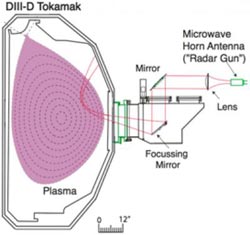Radar gun catches predator shredding turbulence in fusion plasma

This schematic shows the DIII-D tokamak and layout of the UCLA Doppler Backscattering “radar gun” diagnostic. Credit: Lothar Schmitz (UCLA) and M.R. Wade (General Atomics)<br>
Recent experiments carried out at the DIII-D tokamak in San Diego have allowed scientists to observe how fusion plasmas spontaneously turn off the plasma turbulence responsible for most of the heat loss in plasmas confined by toroidal magnetic fields. Using a new microwave instrument based on the same principles as police radar guns, researchers from UCLA observed the complex interplay between plasma turbulence and plasma flows occurring on the surface of tokamak plasmas.
“We found that the turbulent eddies on the surface of the plasma produced surface flows that eventually grow large enough to shred the eddies, turning off the turbulence,” said Dr. Lothar Schmitz, who made the measurements with a microwave instrument designed and built by the Plasma Diagnostics Group at UCLA. “Much like the population of predators and prey find a balance in the wild, we find that the plasma flow and the plasma turbulence reach an equilibrium in the tokamak plasma.”
The finding is important for fusion research because scientists have been seeking to understand how it is that, in a tokamak (a doughnut-shaped vacuum chamber linked by a toroidal magnetic field), the surface plasma turbulence suddenly switches off as the heating power increases. The reduction in turbulence improves the thermal insulation provided by the magnetic field so that much less power is required to achieve temperatures required for fusion (100 million degrees). Until new measurements were obtained, researchers were not able to observe the very rapid change in edge turbulence which occurs in less than a millisecond over a zone less than 1cm thick.
Dr. Schmitz and his coworkers observed the connection between the flow and the turbulence when looking at tokamak plasmas that jumped back and forth from having low thermal insulation to high thermal insulation many times over a few hundredths of a second before finally settling down to the high insulation state (called H-mode by fusion scientists to distinguish it from the low insulation L-mode state). The H mode was discovered in 1982, but the trigger mechanism of the H mode transition has so far been elusive.
The UCLA group designed their new Microwave Doppler Backscattering Diagnostic tool (operating in a way similar to a radar gun), for use on DIII-D to measure the speed at which turbulent eddies propagate in the plasma, as well as the strength of the turbulence. By aiming an array of microwave “radar guns” at the plasma, the time evolution of plasma flow and turbulence intensity can be followed across an extended radial layer in the plasma boundary.
The microwave measurements reveal the predator-prey oscillations between the plasma flow (predator) and density turbulence (prey) by their relative timing (Figure 2). Like the abundance of prey feeds the population growth of predators, high turbulence near the plasma edge is found to drive high flow velocities which, in turn, shred the turbulent eddies and turn off the turbulence (the blue zones in the lower half of Figure 2), causing the flows to die away. The predator-prey cycle then repeats itself: the Zonal Flow dies away once the turbulence has calmed, thus allowing turbulence to grow again (red yellow zones), which restarts the flow. Now that they've seen the process up close, Dr. Schmitz hopes to use the improved understanding to figure out ways to make it easier to achieve and maintain high thermal insulation in future fusion experiments such as the ITER experiment now under construction in France.
This work supported by the U.S. Department of Energy under DE-FC02-04ER54698.
Abstract:
PI2.00002 Predator-Prey Oscillations and Zonal Flow-Induced Turbulence Suppression Preceding the L-H Transition
Session PI2: Pedestal, SOL and Divertor,
Ballroom BD, Wednesday, November 16, 2011, 2:30PM:00PM
Media Contact
More Information:
http://www.aps.orgAll latest news from the category: Physics and Astronomy
This area deals with the fundamental laws and building blocks of nature and how they interact, the properties and the behavior of matter, and research into space and time and their structures.
innovations-report provides in-depth reports and articles on subjects such as astrophysics, laser technologies, nuclear, quantum, particle and solid-state physics, nanotechnologies, planetary research and findings (Mars, Venus) and developments related to the Hubble Telescope.
Newest articles

Superradiant atoms could push the boundaries of how precisely time can be measured
Superradiant atoms can help us measure time more precisely than ever. In a new study, researchers from the University of Copenhagen present a new method for measuring the time interval,…

Ion thermoelectric conversion devices for near room temperature
The electrode sheet of the thermoelectric device consists of ionic hydrogel, which is sandwiched between the electrodes to form, and the Prussian blue on the electrode undergoes a redox reaction…

Zap Energy achieves 37-million-degree temperatures in a compact device
New publication reports record electron temperatures for a small-scale, sheared-flow-stabilized Z-pinch fusion device. In the nine decades since humans first produced fusion reactions, only a few fusion technologies have demonstrated…





















